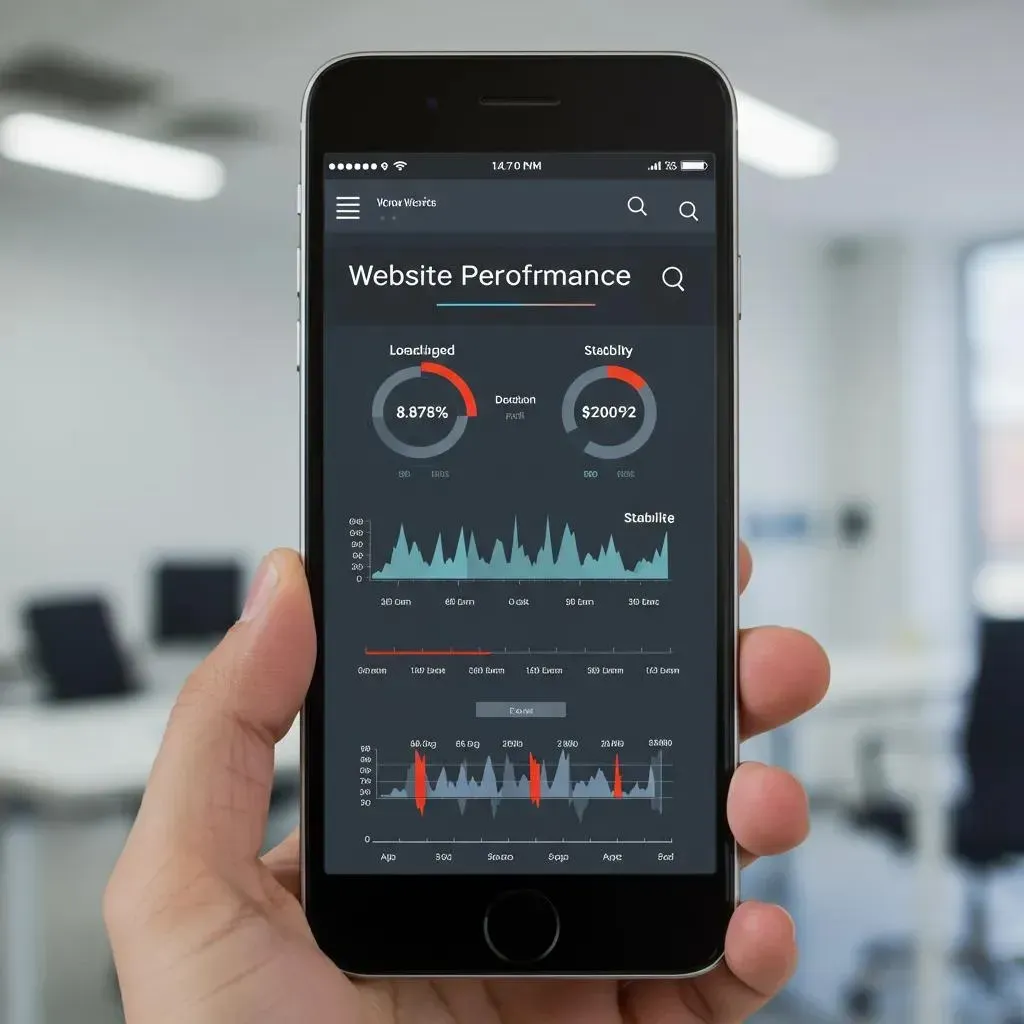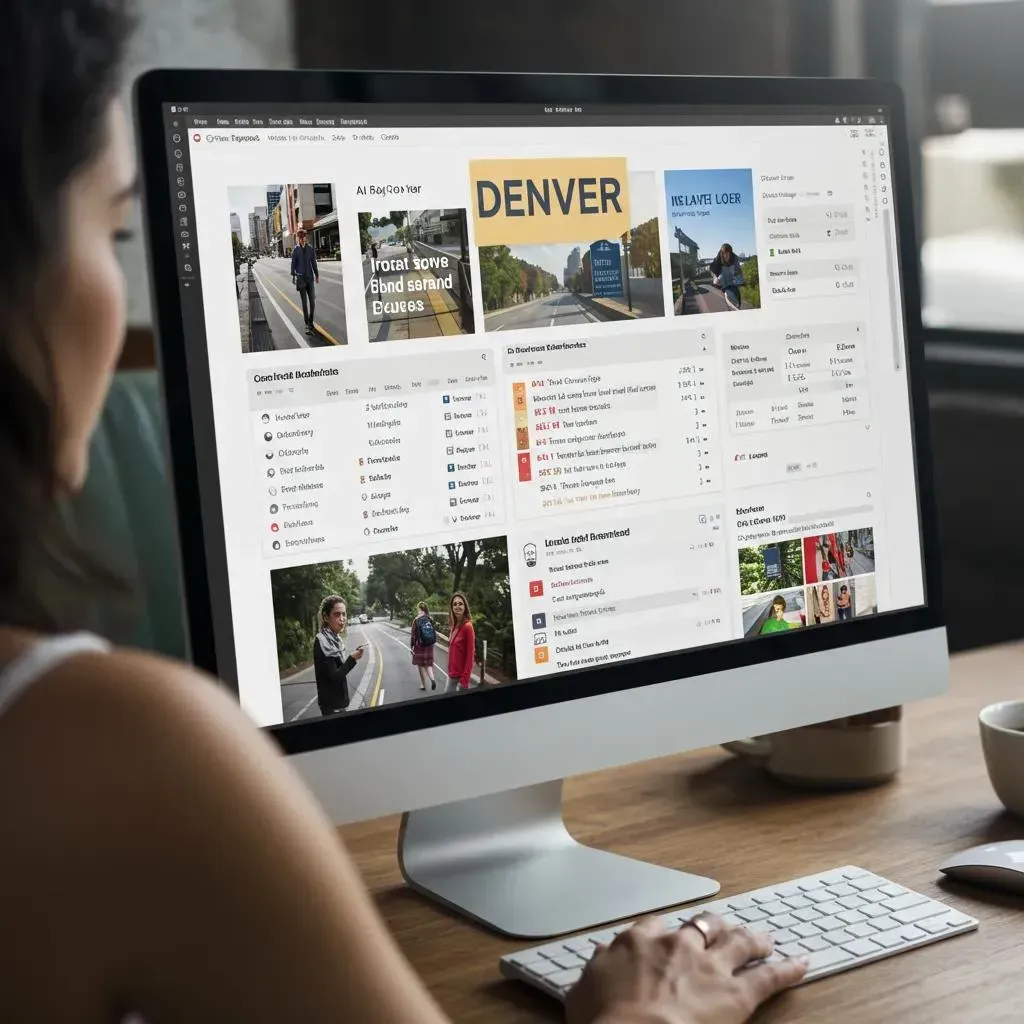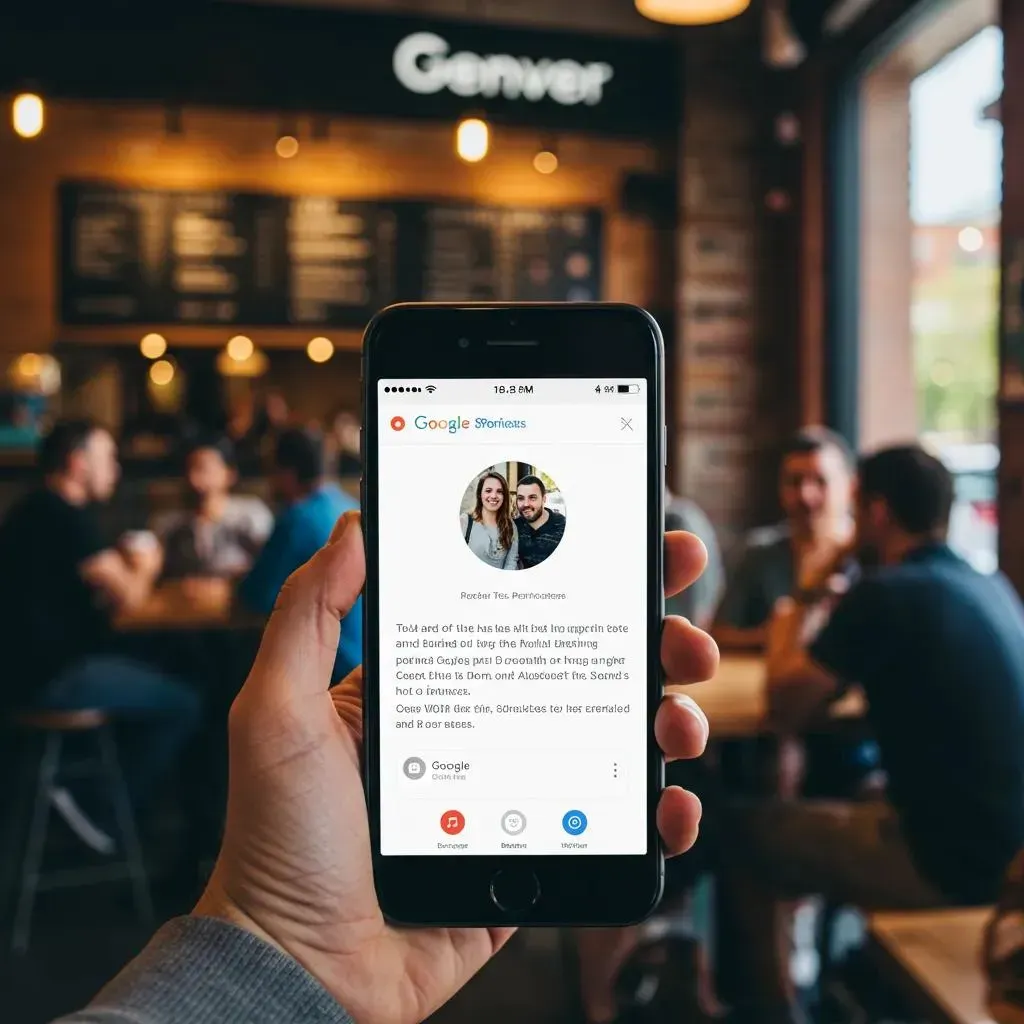Technical SEO Denver 2025: Core Web Vitals Guide
Technical SEO for Local Winners: Speed and Core Web Vitals Optimization for Denver SMBs

Technical local SEO aligns site performance, page experience, and local signals to drive visibility and conversions for Denver small and medium businesses. This guide explains how Core Web Vitals (LCP, INP, CLS), site speed, mobile-first indexing, schema, and Google Business Profile optimization combine into a unified strategy that increases local pack placement, clicks, and in-store visits. Slow pages and unstable layouts hurt mobile searchers with local intent; improving technical metrics directly improves user satisfaction and the signals Google uses to rank local results. You will learn what each Core Web Vital measures, an actionable audit and remediation checklist, practical speed techniques for common SMB platforms, and monitoring KPIs and tools tailored to Denver businesses. The article also covers schema patterns for local entities and how GBP optimization complements technical fixes, plus recommended monitoring cadence to maintain gains. Keywords like technical local SEO Denver, Denver Core Web Vitals audit, and local SEO speed optimization Denver are woven through practical steps and examples applicable to SMB owners and local marketers in 11/2025.
What Are Core Web Vitals and Why Do They Matter for Denver SMBs?

Core Web Vitals are a set of user-centric metrics defined by Google that measure loading performance, interactivity, and visual stability. These metrics—Largest Contentful Paint (LCP), Interaction to Next Paint (INP), and Cumulative Layout Shift (CLS)—quantify user experience, and improvements reduce bounce rates and increase conversions for local searches. For Denver SMBs focused on mobile-driven foot traffic, aligning pages with CWV thresholds improves both the likelihood of ranking in the local pack and the probability a searcher calls, requests directions, or converts. Below is a concise comparison of the three Core Web Vitals with recommended thresholds and the primary UX impact they measure.
Web Performance Tooling and Core Web Vitals Optimization
In today's digital landscape, where users demand instant and seamless web experiences, optimizing web performance has become paramount for businesses to succeed online. According to a recent study[1], 52% of users will abandon a website that takes more than 3 seconds to load. This highlights the importance of measuring website speed and responsiveness using effective performance optimization techniques. This paper delves into the significance of web performance tooling in measuring and optimizing key performance indicators (KPIs) known as "web vitals." It explores popular tools such as Lighthouse, PageSpeed Insights, and WebPageTest, analyzing their functionalities and roles in enhancing web performance [2][3][4]. These tools help evaluate critical metrics like Largest Contentful Paint (LCP) and First Input Delay (FID), which directly impact userexperience. Additionally, the paper investigates the importance of optimizing core web vitals like LCP and FID and their impact on key metrics such as bounce rate, conversion rate, and time on site. Studies show even small delays in LCP, CLS and FID can negatively affect these business metrics[7].
Web performance tooling and the importance of web vitals, MK Dobbala, 2022Web Performance Tooling and Core Web Vitals Optimization
In today's digital landscape, where users demand instant and seamless web experiences, optimizing web performance has become paramount for businesses to succeed online. According to a recent study[1], 52% of users will abandon a website that takes more than 3 seconds to load. This highlights the importance of measuring website speed and responsiveness using effective performance optimization techniques. This paper delves into the significance of web performance tooling in measuring and optimizing key performance indicators (KPIs) known as "web vitals." It explores popular tools such as Lighthouse, PageSpeed Insights, and WebPageTest, analyzing their functionalities and roles in enhancing web performance [2][3][4]. These tools help evaluate critical metrics like Largest Contentful Paint (LCP) and First Input Delay (FID), which directly impact userexperience. Additionally, the paper investigates the importance of optimizing core web vitals like LCP and FID and their impact on key metrics such as bounce rate, conversion rate, and time on site. Studies show even small delays in LCP, CLS and FID can negatively affect these business metrics[7].
Web performance tooling and the importance of web vitals, MK Dobbala, 2022
- Largest Contentful Paint (LCP)
- What it measures: The time it takes to render the largest visible element on the page (typically the hero image or main text block).
- Recommended threshold: ≤ 2.5 seconds (good) — ensures fast loading and better user experience.
- Interaction to Next Paint (INP)
- What it measures: The overall responsiveness of the page over time; replaces First Input Delay (FID) as the main interactivity metric.
- Recommended threshold: Median INP ≤ 200 ms (good) — indicates consistently responsive user interactions.
- Cumulative Layout Shift (CLS)
- What it measures: The visual stability of the page, tracking how much content unexpectedly shifts during loading.
- Recommended threshold: CLS ≤ 0.1 (good) — ensures a stable layout and prevents frustrating visual jumps.
This clarifies how each metric maps to user experience and local ranking signals. Understanding these thresholds helps Denver businesses prioritize fixes that yield measurable local SEO outcomes and better user engagement. The next subsection defines each metric, where to measure it, and common real-world causes that Denver sites typically encounter.
What Are LCP, FID, and CLS Metrics in Core Web Vitals?
LCP measures how quickly the main content of a page becomes visible; slow LCP often stems from large hero images, render-blocking CSS, or slow server response times. INP (which replaced FID) evaluates responsiveness across the full lifecycle of interaction by measuring latency for user interactions and is affected by heavy main-thread work and long-running JavaScript. CLS quantifies unexpected layout shifts caused by images without dimensions, late-loading ads, or dynamically injected content. Field data from PageSpeed Insights and Google Search Console gives real-world CWV distribution, while Lighthouse and WebPageTest provide lab diagnostics to reproduce and debug issues. For Denver SMBs, common symptoms include delayed hero rendering on mobile, sluggish booking forms, and content shifts when geo-specific ads or location widgets load, all of which degrade conversions and local intent fulfillment.
How Do Core Web Vitals Impact Local Search Rankings in Denver?
Core Web Vitals influence local search by contributing to page experience signals that Google uses alongside relevance and prominence to rank results for local intent queries. Pages that meet CWV thresholds are more likely to retain mobile users searching for “near me” or “Denver” services, raising behavioral signals like dwell time and CTR that indirectly support local ranking. Improved CWV also increases the likelihood that Google surfaces rich snippets or favours mobile results in the local pack, which directly affects foot traffic and calls for SMBs. For Denver-specific scenarios—such as a café appearing for “best espresso near Union Station”—a faster, stable mobile page can convert a search into a visit; conversely, slow or jumpy pages lose immediate customer opportunities. These user-experience gains translate into measurable business KPIs like increased click-to-call rates and map-driven directions.
How Can Denver SMBs Audit and Improve Their Core Web Vitals?
A clear audit workflow helps Denver SMBs find the highest-impact CWV fixes quickly: discover priority URLs, collect field and lab data, categorize issues by impact and effort, remediate the top items, and validate improvements with RUM and lab tests. This structured approach focuses resources on pages that drive conversions—homepage, category pages, and local landing pages—so remediation produces fast local SEO wins. Below is an actionable checklist that teams and owners can follow to perform a Core Web Vitals audit and remediation plan.
- Inventory priority URLs: list pages driving organic and GBP traffic, including location landing pages.
- Gather field data: export Core Web Vitals reports from Google Search Console and PageSpeed Insights for real-user metrics.
- Run lab diagnostics: use Lighthouse and WebPageTest to reproduce and measure LCP, INP, and CLS causes.
- Prioritize fixes: rank issues by impact vs. effort (high impact, low effort first).
- Implement quick wins: optimize images, add width/height attributes, defer non-critical scripts, enable caching.
- Validate and monitor: deploy RUM, re-check field metrics weekly, and iterate based on trends.
This numbered checklist provides an explicit roadmap from discovery to monitoring and is optimized for snippet capture as a step-by-step audit workflow. For SMBs that prefer a hands-on technical partner for audits and prioritized remediation plans, practical next steps include commissioning a foundational technical SEO build that delivers a CWV report and a prioritized fix list from an experienced local agency.
For Denver businesses seeking an outsourced audit, Lingows Media offers Foundational SEO Builds focused on technical assessments that translate CWV data into prioritized remediation actions. These foundational services include a full Core Web Vitals report, a prioritized remediation roadmap, and implementation recommendations tailored to common SMB platforms. Engaging such a service accelerates diagnosis and helps internal teams or external developers implement the highest-impact changes without guessing.
What Tools Are Best for Auditing Core Web Vitals in Denver Local SEO?
Effective auditing requires a complementary set of field and lab tools: Google Search Console surfaces site-wide CWV trends, PageSpeed Insights provides URL-level field and lab scores, Lighthouse offers actionable lab audits, and WebPageTest enables advanced filmstrip and waterfall analysis. Real User Monitoring (RUM) solutions capture user interaction patterns across devices and networks, which is crucial for Denver’s mixed urban and mountain-region connectivity patterns. Each tool serves a purpose—GSC for trend detection, PSI for quick URL checks, Lighthouse for developer recommendations, and WebPageTest for network-level diagnostics—so a combined stack yields both diagnostics and validation. Use GSC weekly for trend monitoring and run Lighthouse or WebPageTest after changes to verify improvements in LCP, INP, and CLS.
What Practical Steps Improve LCP, FID, and CLS for Local Business Websites?
Practical remediation focuses on resource optimization and layout stability: compress and serve responsive images with modern formats, implement efficient caching and CDN delivery, minimize main-thread JavaScript, and reserve space with dimension attributes or CSS aspect-ratio to prevent layout shifts. Specific tactics include lazy-loading offscreen images, preloading hero assets, deferring non-critical third-party scripts, using font-display strategies, and inlining critical CSS. These steps reduce time-to-first-contentful-paint, lower INP by shortening JavaScript execution, and eliminate CLS by avoiding late DOM inserts. For many SMBs, quick wins—image optimization and adding intrinsic dimensions—produce immediate LCP and CLS improvements while more complex fixes (server tuning, code splitting) follow after prioritization.
Website Optimization and Core Web Vitals for E-commerce
XYZ website is a business website that operates in the field of e-commerce which is implemented through websites and applications, for several years the website has had a percentage of users' usage speed which has decreased quite a bit and has become old, due to lack of maintenance of some of the features contained in the website application which have an impact on the lack of customer interest in buying goods on the XYZ website and more influential in terms of access from searching e-commerce notifications from Google that if the percentage of websites decreases over a long period of time, this will result in websites not being allowed to publish advertisements. In this study, we analyze the problem to understand the problem starting from small things, namely from the use of programming languages, the data provided, the use of writing code, third party or vendor support, filling out website content, and websites using vital core web architecture.
The Website Optimization and Analysis on XYZ Website using the Web Core Vital Method, A Zahra, 2023
Why Is Website Speed Optimization Critical for Denver Local SEO Success?

Website speed optimization reduces friction for local users and amplifies the ROI of marketing spend by increasing conversions from organic and paid channels. Faster pages lead to higher engagement, lower bounce rates, and improved conversion paths for actions that matter to Denver SMBs—calls, bookings, and map directions. In a local context, speed acts as an amplifier: when search intent signals strong local intent, page speed determines whether intent converts to action. Below is a comparison of common speed techniques, their primary effect, and expected impact/complexity for typical SMB implementations.
- CDN (Content Delivery Network)
- Primary effect: Reduces latency and Time to First Byte (TTFB) across different geographic regions.
- Expected impact / complexity: High impact / Moderate complexity — delivers faster global load times and improved Core Web Vitals.
- Caching (Server & Browser)
- Primary effect: Serves repeat visitors faster by storing assets locally or at the edge.
- Expected impact / complexity: High impact / Low–Moderate complexity — significantly boosts repeat load speed and overall performance.
- Image Optimization (Responsive, WebP/AVIF)
- Primary effect: Reduces page payload size and improves Largest Contentful Paint (LCP).
- Expected impact / complexity: High impact / Low complexity — quick win for faster visual rendering and better mobile performance.
- Minify & Async/Defer JS/CSS
- Primary effect: Lowers main-thread blocking by optimizing JavaScript and CSS delivery.
- Expected impact / complexity: Medium–High impact / Moderate complexity — improves interactivity and responsiveness metrics like INP.
This comparison helps Denver SMBs select techniques that match budget, technical resources, and expected return. Quick wins like image optimization and caching typically produce fast improvements, while server tuning and advanced code-splitting deliver sustained performance gains for higher-traffic sites. The next subsection explains how page speed affects local ranking signals and user engagement in greater detail.
How Does Page Speed Affect Local SEO Rankings and User Engagement?
Page speed influences local SEO indirectly through engagement metrics that Google evaluates: faster pages improve click-through rates, reduce pogo-sticking, and increase conversion likelihood from local SERPs and GBP interactions. For mobile-first local searches, even fractional improvements in LCP or INP can increase conversions for bookings or calls, translating into measurable revenue gains. Studies and recent analyses show consistent correlations between improved speed metrics and higher organic performance, particularly on mobile devices with local intent. For Denver SMBs serving commuters or tourists, ensuring pages load quickly on cellular networks is critical; this reduces friction for urgent local queries like “emergency locksmith Denver” or “late-night pizza near me.”
What Are Effective Speed Optimization Techniques for Denver SMB Websites?
Effective techniques range from low-effort wins to engineering projects: implement responsive images and modern formats, enable server-side caching and edge caching via a CDN, reduce third-party script usage, and apply critical CSS inlining for above-the-fold content. Platform-specific recommendations include plugin-based image optimization for common CMSs and server-side caching for custom stacks; these options vary in complexity and cost. For SMBs in Denver weighing local hosting vs. global CDN, the best approach often combines a cost-effective CDN with origin optimizations to ensure both local and remote users experience consistent performance. Prioritize measures that lower LCP and INP first, then target CLS fixes and long-term architectural improvements.
What Are the Essential Technical SEO Foundations for Denver Local Businesses?
Technical SEO foundations for local businesses include crawlability and indexability, coherent site architecture with local landing pages, mobile-first parity, structured data for local entities, and a fast, stable page experience. These elements create the underlying signals search engines use to understand relevance and deliver local results. Well-structured local pages that load quickly and include LocalBusiness schema form a clear entity signal for Google’s knowledge systems and can improve rich result eligibility. The following list summarizes essential technical foundations Denver SMBs should prioritize for local SEO success.
- Ensure crawlability and indexability: use robots.txt correctly, avoid blocking essential assets, and submit sitemaps.
- Maintain clear site architecture: create location-specific landing pages and logical URL paths.
- Implement mobile-first parity: keep content and structured data identical on mobile and desktop.
- Add LocalBusiness schema: mark up name, address, service area, and service offerings as structured data.
These foundational elements interlock: crawlability enables indexing of schema-marked pages, and mobile parity ensures the same content evaluated by mobile-first indexing. Next, we examine how mobile-first indexing changes practical checks for Denver SMB sites.
How Does Mobile-First Indexing Influence Technical SEO for Denver SMBs?
Mobile-first indexing means Google primarily uses the mobile version of a site for indexing and ranking, so content parity between mobile and desktop is essential. Denver SMBs must ensure structured data, meta content, and primary page content are present on mobile; omissions on mobile can lead to lower visibility. Practical checks include comparing rendered mobile content in Search Console, verifying mobile-only resources are accessible to crawlers, and testing responsiveness across common mobile devices and network conditions in Denver. Fixes often involve ensuring dynamic content loads without blocking scripts and that structured data is implemented in the mobile DOM. Maintaining parity prevents indexing surprises and supports consistent local ranking signals.
How Can Schema Markup Boost Local SEO for Denver Businesses?
Schema markup clarifies entity information to search engines, improving the likelihood of rich snippets, knowledge panels, and accurate GBP displays. Relevant schema types for Denver SMBs include LocalBusiness, Service, Product, and Review markup, each enhancing context for local queries. Implementing minimal, validated structured data—business name, service area, accepted payment types, and review aggregates—helps search engines attribute correct entity signals to local pages and GBP. Validation tools such as rich results testing and structured data validators confirm correct implementation. Prioritizing LocalBusiness and Service schema on location pages yields a significant visibility boost with relatively low implementation effort.
Local SEO for Retailers: Google Optimization and Traffic Growth
The Purpose of the presented research is to substantiate the importance of the local optimization of the retailer’s business for search engines to increase organic traffic; to represent insights and give practical recommendations for retailers regarding local optimization of their business in Google as part of an effective marketing strategy; to create the typical valid data micromarking (by the example of the Ukrainian retailer), which will contribute to an advantageous placement in the Local Pack in comparison with competitors, and increase organic traffic and conversion.
Business optimization in the digital age: Insights and recommendations, A Natorina, 2020
How Does Google Business Profile Optimization Enhance Technical SEO for Denver SMBs?
Google Business Profile (GBP) is both a discovery and local ranking signal that complements on-site technical health; consistent NAP data, optimized categories, and regular GBP content improve local prominence and click-through to optimized pages. GBP and site performance together create a seamless user journey: fast landing pages linked from GBP increase conversions for calls and directions. GBP also surfaces photos, posts, and services that must reflect the content and schema on the website to reinforce entity signals. The subsection below lists practical GBP best practices tailored to Denver businesses.
- Keep NAP consistent across site schema and citations.
- Choose precise primary and secondary categories reflecting services.
- Upload high-quality, localized photos and maintain a regular posting cadence.
- List services and attributes clearly and align them with on-site schema.
These practices ensure GBP complements technical SEO efforts and strengthens local entity signals; next, we discuss how citations and reviews further influence local rankings.
For businesses seeking professional support with GBP optimization, Lingows Media’s Local SEO & Google Strategies offering manages GBP improvements as part of broader local signal programs. Managed GBP work includes category optimization, content cadence recommendations, photo and service alignment with on-site schema, and integration with citation health efforts to maximize local visibility.
What Are Best Practices for Google Business Profile Optimization in Denver?
Best practices include fully completing profile fields, using localized descriptions with relevant keywords, and regularly adding photos and posts to demonstrate activity and relevance. Selecting accurate categories and service items helps GBP match queries to your business, while maintaining up-to-date hours and attributes supports user expectations. Frequency recommendations include weekly posts and monthly photo updates to keep GBP signals fresh. For Denver SMBs, adding neighborhood-specific terms and seasonal attributes (e.g., “patio seating” or “ski-season hours”) can increase relevance for hyperlocal searches and events.
How Do Local Citations and Reviews Affect Technical SEO and Local Rankings?
Local citations and reviews function as external validation and trust signals that interact with on-site schema and GBP signals to influence local rankings. Consistent NAP data across high-quality citations reduces confusion for search engines and improves entity resolution, while a steady flow of positive reviews increases click-through and perceived trust. Practical steps include auditing citation consistency, prioritizing high-authority directories, and implementing polite review solicitation workflows that encourage timely responses. Integrating review schema into site markup and responding publicly to reviews strengthens both user trust and structured-data signals for local search.
How Can Denver SMBs Monitor and Maintain Technical SEO, Speed, and CWV Performance?
Monitoring and maintenance require a focused KPI set, a monitoring stack that includes field and lab tools, and a cadence for audits and remediation. Key KPIs include LCP, INP, and CLS distributions, organic visibility for local queries, GBP metrics (searches, views, actions), and conversion metrics like calls and directions. A recommended monitoring cadence is weekly checks for trending regressions, monthly deep audits, and quarterly reviews aligned with business campaigns or seasonal shifts. The table below compares recommended monitoring tools, the metrics they cover, and suggested monitoring frequency to help Denver SMBs create an actionable stack.
- Google Search Console
- Metric coverage: Tracks site-wide Core Web Vitals (CWV) distribution and index coverage issues.
- Recommended frequency: Weekly to monthly — ideal for ongoing performance and indexing health monitoring.
- PageSpeed Insights / Lighthouse
- Metric coverage: Provides URL-level LCP, INP, CLS data and lab diagnostics for performance insights.
- Recommended frequency: After major site changes or monthly spot checks — useful for validating improvements.
- WebPageTest
- Metric coverage: Offers detailed waterfall analysis, filmstrip view, and network request tracing.
- Recommended frequency: For deep performance investigations — best used during audits or troubleshooting.
- GA4 / RUM (Real User Monitoring)
- Metric coverage: Measures behavior metrics, conversions, and real-user latency data.
- Recommended frequency: Weekly — helps identify performance trends and user experience issues over time.
- Local Rank Tools
- Metric coverage: Tracks local pack rankings and Google Business Profile (GBP) actions such as clicks and calls.
- Recommended frequency: Weekly to monthly — supports consistent local SEO performance tracking.
This helps prioritize tools for different monitoring needs and clarifies which instrument to use for trend detection versus deep debugging. The following subsection defines the KPIs Denver businesses should track and how to interpret them for local SEO impact.
What KPIs Should Denver Businesses Track for Technical SEO and CWV Success?
Track a combination of CWV metrics (LCP, INP, CLS) with distribution thresholds, behavioral KPIs (bounce rate, average session duration), local SEO KPIs (GBP views, local pack position, clicks-for-directions), and conversion KPIs (calls, form submissions, bookings). Target thresholds: LCP ≤ 2.5s, median INP ≤ 200 ms, CLS ≤ 0.1; deviations from these targets often precede drops in engagement. Map each KPI to a business outcome—for example, a 0.5s LCP improvement that reduces bounce on a booking page should result in measurable increases in reservations or calls. Monitoring these KPIs in aggregate allows Denver SMBs to prioritize technical fixes that directly support revenue.
Which Tools Help Monitor Website Speed, Core Web Vitals, and Local SEO Performance?
A practical monitoring stack pairs field data and lab diagnostics: use Google Search Console for site-wide trends, PageSpeed Insights for targeted URL checks, Lighthouse and WebPageTest for developer diagnostics, GA4 for behavior and conversion analytics, and a local-rank tracking tool for GBP and local pack movements. Recommended cadences include weekly GSC scans for regressions, monthly PSI/Lighthouse checks on priority pages, and ad-hoc WebPageTest runs pre- and post-deployment. For reporting, combine automated alerts for major regressions with a concise monthly report that ties technical metrics to local business KPIs.
For Denver SMBs wanting ongoing monitoring and a prioritized remediation pipeline, Lingows Media offers technical SEO assessments that pair AI-driven diagnostics with high-end web design expertise to implement performance improvements and sustained monitoring. Engaging a partner can accelerate fixes and maintain a disciplined monitoring cadence while tying technical metrics directly to GBP and local conversion outcomes. Requesting a Core Web Vitals audit or technical SEO assessment with an agency skilled in AI-driven optimization and web design ensures a pragmatic path from diagnosis to measurable local wins.
Frequently Asked Questions
What is the role of mobile-first indexing in local SEO for Denver SMBs?
Mobile-first indexing means that Google primarily uses the mobile version of a website for ranking and indexing. For Denver small and medium businesses (SMBs), this emphasizes the need for mobile-optimized content that mirrors desktop versions. If the mobile site lacks essential information or structured data, it can lead to lower visibility in search results. Ensuring that mobile pages are fully functional and contain all necessary elements is crucial for maintaining local SEO performance and attracting mobile users searching for local services.
How can Denver SMBs effectively use schema markup for local SEO?
Schema markup enhances how search engines understand a business's information, improving the chances of appearing in rich snippets and knowledge panels. For Denver SMBs, implementing LocalBusiness schema is particularly beneficial. This includes marking up details like business name, address, phone number, and service offerings. By providing structured data, businesses can improve their visibility in local search results and ensure that potential customers receive accurate information, which can lead to higher engagement and conversion rates.
What are the common pitfalls to avoid when optimizing Core Web Vitals?
When optimizing Core Web Vitals, Denver SMBs should avoid common pitfalls such as neglecting mobile optimization, failing to prioritize high-impact fixes, and overlooking the importance of regular monitoring. It's essential to ensure that all elements of a website, including images and scripts, are optimized for speed and stability. Additionally, businesses should not ignore user feedback, as real-world experiences can highlight issues that metrics alone may not reveal. Regular audits and updates are crucial to maintaining optimal performance.
How does website speed influence customer behavior for local businesses?
Website speed significantly impacts customer behavior, especially for local businesses in Denver. Faster loading times lead to lower bounce rates, higher engagement, and increased conversion rates. Studies show that users are more likely to abandon a site that takes longer than three seconds to load. For local searches, where users often seek immediate solutions, a slow website can result in lost opportunities. Therefore, optimizing speed is essential for retaining potential customers and driving foot traffic to physical locations.
What are the best practices for maintaining Google Business Profile (GBP) optimization?
Maintaining an optimized Google Business Profile (GBP) involves several best practices. Denver SMBs should ensure that their NAP (Name, Address, Phone number) information is consistent across all platforms. Regularly updating GBP with high-quality images, posts, and accurate service descriptions is crucial. Engaging with customer reviews and responding promptly can enhance trust and visibility. Additionally, using localized keywords in the business description can improve relevance for local searches, making it easier for potential customers to find the business online.
What tools can Denver SMBs use to monitor their local SEO performance?
Denver SMBs can utilize a variety of tools to monitor their local SEO performance effectively. Google Search Console is essential for tracking site-wide trends and indexing issues. PageSpeed Insights provides insights into page speed and Core Web Vitals metrics. For more detailed diagnostics, Lighthouse and WebPageTest are valuable for identifying specific performance issues. Additionally, local rank tracking tools can help monitor visibility in local search results and GBP performance, allowing businesses to adjust their strategies based on real-time data.
Conclusion
Optimizing technical SEO and Core Web Vitals is essential for Denver SMBs to enhance user experience and drive local engagement. By improving site speed and stability, businesses can significantly increase conversion rates and visibility in local search results. Implementing the strategies outlined in this guide will empower you to attract more customers and improve your online presence. Start your journey towards better local SEO today by exploring our tailored services for Denver businesses.













